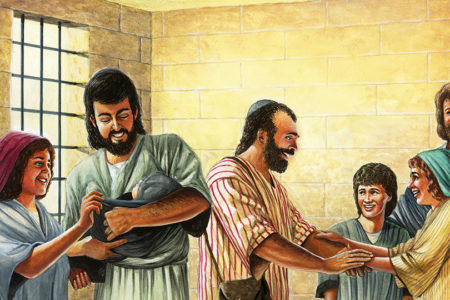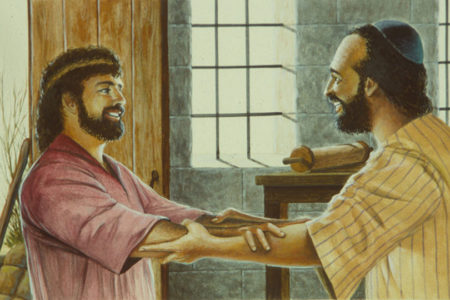A Call to Hope 1 Thessalonians 4
The New Testament epistles do not teach systematic theology. That statement may appear shocking to some readers, but a little reflection will clarify what is meant. A systematic theology textbook gathers all that the Bible teaches on a certain doctrine and presents the information in a systematic fashion. While that method can be valuable, it should be remembered that theology was not presented in such a way by the apostles in their writings. Whenever Paul, for example, presented a great doctrine in his epistles, it was always in the context of helping to meet a practical need that existed among his readers. This is particularly true in his first epistle to the Thessalonians. Paul did not present a systematic theology of the Lord’s coming as such. He gave them information on the Lord’s return as it related to situations in their own personal lives.
Each of the five chapters of this epistle ends with a reference to the Lord’s return. Each of these references also relates to some practical need of the readers. Truly doctrine is always to be related to duty, and precept is always related to practice.
First Thessalonians 4 is an intensely practical chapter that also contains the most detailed description of the Rapture in the Bible. Paul’s purpose in mentioning the Rapture was to comfort his readers by correcting their views about the future of their departed loved ones who died as believers. He wanted to encourage them and did so by referring to the Rapture and the resurrection.
The great apostle sought to accomplish two main purposes in 1 Thessalonians 4. In verses 1 to 12 he issued a call to holiness, and in verses 13 to 18 he issued a call to hope. Paul opened the chapter by exhorting his readers to continue to “walk” in accordance with the teaching he had already given them during his brief missionary visit there (v. 1; see Acts 17:1–9). He then related this call to holiness to three particular Christian virtues: purity (vv. 3–8), charity (vv. 9–10), and dignity (vv. 11–12).
Paul clearly stated the will of God for his readers: Their sanctification should continue by abstaining from sexual immorality (v. 3). He then stated, “That every one of you should know how to possess his vessel in sanctification and honor” (v. 4). Interpreters debate whether the “vessel” referred to is one’s own body or one’s own wife. Since the context (vv. 4–6) focuses on illicit sexual relationships and sexual defrauding, he must be referring to sexual purity relating to one’s spouse. This parallels Peter’s reference to the wife as the “weaker vessel” (1 Pet. 3:7). In any case, Paul’s purpose is clear: God has called believers to purity (4:7). In light of the gross immorality of the ancient Greek world, when abstinence from illicit sexual practices was unheard of, this exhortation was greatly needed. In light of the gross immorality of this present age, the exhortation is more relevant than ever.
Paul next exhorted his readers to excel in charity, or love of the brethren (4:9–10). The word he used is philadelphia in the Greek. He actually said that love is so much a part of their Christian experience that no one had to remind them of it—God had already poured that love into them at their conversion (see 1 Jn. 4:7–21). And yet each of us still can manifest that love more and more in our relationships with others.
In this call to holiness (vv. 1–12), Paul mentioned another virtue—dignity (vv. 11–12). Believers should not be idle or dependent on others but should recognize the dignity of manual labor. Paul had exemplified this by his own labor as a tentmaker among them (see 2:9 and Acts 18:3). By being diligent in manual labor, the believer also will gain the respect of unbelievers (4:12).
In the second section of this chapter, Paul issued a ringing call to hope (vv. 13–18). The Thessalonian believers were discouraged that their departed loved ones would miss the blessings of the Lord’s soon return. In light of this misunderstanding, Paul gave them some new information: “But I would not have you to be ignorant, brethren, concerning them who are asleep, that ye sorrow not, even as others who have no hope” (4:13). The heathen world manifested utter hopelessness in the face of death. A tombstone discovered in the ancient cemetery of Thessalonica proclaimed, “I was not—I became—I am not—I care not.” Such hopelessness must not characterize the believer. Paul gave them hope by discussing three great themes in verses 14 to 17: (1) the return of the Savior; (2) the resurrection of the sleepers; and (3) the Rapture of the saints.
The Return of the Savior
Jesus had promised to return and take His followers back to Heaven (Jn. 14:1–3). Paul added some further details: “For the Lord himself shall descend from heaven with a shout, with the voice of the archangel, and with the trump of God” (v. 16). Some commentators see three events accompanying this return: a shout, the voice of the archangel, and the trumpet of God. The original language, however, permits the idea that the shout will actually be given “with the voice of the archangel.” The only archangel mentioned by name in Scripture is Michael (Jude 9), although Gabriel is mentioned as an angel (Lk. 1:26). We do not know what his shout will be, but the word carries the idea of a military order issued by a commanding officer. Could it be a command similar to the one heard by John in Revelation 4:1, “Come up here”? If Michael issues this command to the saints, it would then precede his action of standing up for Israel at the beginning of the Tribulation period (see Dan. 12:1). Thus, Michael’s shout for the removal of the Church will be immediately followed by his standing up for Israel during her time of tribulation.
God’s trumpet will also sound (v. 16). Paul elsewhere referred to this as the “last trump” (1 Cor. 15:52). This trumpet should not be confused with the seven trumpets of Revelation 8–11, for they are trumpets related to the world’s judgment. This, however, is the last trumpet for the Church. The series of different trumpet blasts during the Festival of Trumpets (Rosh Hashanah) illustrates the distinctions among the different trumpets in God’s plan of blessing for the Church and His plan of judgment for the world.
The Resurrection of the Sleepers
Accompanying the return of the Savior will be the bodily resurrection of those believers who have died: “and the dead in Christ shall rise first” (v. 16b). Here Paul dealt directly with the problem facing the Thessalonian believers. Since they fully expected the coming of the Lord, they were concerned that those among them who had died would miss out on the blessed hope. Three times Paul described the condition of those departed ones as being “asleep” (vv. 13, 14, 15). This is a New Testament phrase to describe the state following a believer’s death (Jn. 11:11–13). This phrase is appropriate in two ways. When we sleep, our bodies are at rest but our minds are still very active—we do not cease to exist. In the same way, departed believers are with Christ (see 2 Cor. 5:5–8; Phil. 1:21), not in some sort of soul sleep, as cults teach. Furthermore, the metaphor of sleep implies that one will eventually awaken. And that is exactly the case with the dead in Christ—they will rise bodily someday. To relieve the concern of the Thessalonians, Paul declared that the resurrection of the sleeping saints will take place immediately prior to the Rapture of the awake saints.
Therefore, the answer to the Thessalonians’ “sorrow” in verse 13 is that the souls of their loved ones are safely in the arms of Jesus at present, and their bodies will be raised to join their departed souls at the coming of the Lord. “For if we believe that Jesus died and rose again, even so them also who sleep in Jesus will God bring with him” (v. 14). A widower was once asked, “How are you recovering from the loss of your wife?” He replied, “Oh, but she is not lost. I know exactly where she is—she’s with Jesus!”
Paul did not describe the nature of the resurrection body in this passage. Elsewhere he gave further information on this subject (1 Cor. 15:51–53; Phil. 3:21). He relied on the concept of the power of God, which can transform our corruptible carcasses, as sufficient to answer the many questions that people have about the nature of the resurrection. The Apostle John’s simple statement says it all: “Beloved, now are we the children of God, and it doth not yet appear what we shall be, but we know that, when he shall appear, we shall be like him; for we shall see him as he is” (1 Jn. 3:2).
The Rapture of the Saints
“Then we who are alive and remain shall be caught up together with them in the clouds, to meet the Lord in the air; and so shall we ever be with the Lord” (v. 17). This marvelous verse declares that there will be a generation of believers who will not suffer physical death. Elsewhere Paul declared, “We shall not all sleep, but we shall all be changed” (1 Cor. 15:51). Immediately following the bodily resurrection of those who are asleep in Christ, those who are still alive will be “caught up.” The English word rapture is not in the Bible, but the teaching of the Rapture certainly is. The word rapture is based on the Latin word for caught up or snatched away. The Greek word in verse 17 is used elsewhere of a wolf snatching sheep (Jn. 10:12), of Philip’s being caught away bodily from the Ethiopian eunuch (Acts 8:39), of the Roman soldiers snatching Paul from the crowd (Acts 23:10), and of Paul’s being caught up to the third heaven (2 Cor. 12:2–3).
Three little words follow the phrase “caught up”—“together with them.” This is the great reunion of loved ones separated by death. We will see them again. What a comfort this must have been to the Thessalonian believers. Some churches organize homecoming Sundays, when former members join together for a day. The homecoming reunion for the entire church will take place someday as well—and last for eternity!
The locale of that reunion is described as “in the clouds, to meet the Lord in the air.” Some view these clouds as literal; others see them as symbolizing the presence of God. Perhaps the idea is similar to that of the “cloud of witnesses” in Hebrews 12:1. In other words, there will be an astral traffic jam as clouds of believers rise simultaneously to meet their Lord. The meeting place is in the air—the place of Satan’s domain (Eph. 2:2). How appropriate that this triumphal procession of blood-washed saints will proceed safely through enemy territory with no fear of attack from his infernal majesty!
Finally, the most blessed characteristic of this Rapture is that we will then “ever be with the Lord.” Nothing is mentioned about our reversing gears and returning to the earth immediately. No, we will continue our ascent to His Father’s house, as Jesus promised in John 14:3. There the bride and the Bridegroom will be together before her public presentation at the glorious revelation of the Savior seven years later (see Rev. 19:7–14).
Conclusion
A visitor to England noticed the following epitaph on a tombstone in a country church cemetery:
Pause, my friend, as you pass by. As you are now, so once was I. As I am now, so you will be. Prepare my friend, to follow me.
However, the wise visitor scribbled the following note and attached it to the epitaph:
To follow you is not my intent,
Until I know which way you went!
Do you know, my dear friend, which way you are going when you depart this earthly life? Because Jesus died and rose again, we can have the hope of eternal life. Trust Him today, and you can possess this blessed hope.







